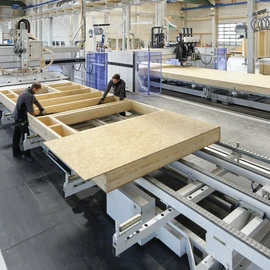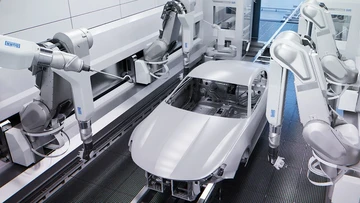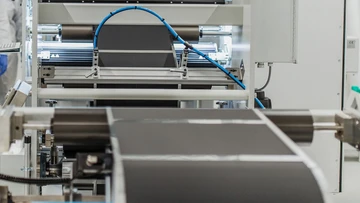“Building with timber has left the niche it once occupied and is increasingly being seen as a sustainable alternative to conventional construction with cement and bricks,” says Dr. Jochen Weyrauch, CEO of Dürr AG. In Baden-Württemberg, timber already accounts for almost 40% of newly constructed detached and semidetached houses. “The advantages are obvious: Wood is a renewable raw material with an excellent carbon footprint. Timber houses are a carbon sink, significantly surpassing other buildings in terms of sustainability,” says the Dürr Group CEO.
Until now, mostly smaller houses have been built from timber. Now, however, this natural building material is increasingly also being used in large buildings and entire residential complexes. In addition to sustainability, timber construction offers many other advantages. Ceilings, walls and other wooden elements are prefabricated at the factory and can be quickly assembled at the building site. This not only saves time and money but also reduces noise, dust and construction waste as well as the traffic obstructions caused by building sites. Wood is second to none when it comes to urban densification: The structures are lightweight and can be readily placed on top of existing houses. This creates new residential space without the need for any additional surface sealing.
Modern timber construction also eases the consequences for craft businesses and construction companies of the shortage of skilled workers as fewer employees are required at the construction sites and timber construction elements are ideal for automated production. An investment in an automatic system is an option even for smaller carpentry businesses as they are able to lower their dependence on the tight labor market, while at the same time being able to take on more orders and expand.
The market for systems for the production of timber construction elements is growing by a good 6% annually. For this reason, the HOMAG Group has expanded its range of technologies. To complement its German subsidiary WEINMANN, it recently acquired Danish mechanical engineering companies System TM and Kallesoe. In addition to WEINMANN systems for the production of frame and wall elements, HOMAG now also offers high-frequency presses for cross-laminated timber boards as well as systems for sorting, optimizing and finger-jointing solid wood boards.
New players taking an innovative approach
With its expanded range, HOMAG is addressing a market that is in the throes of reorganization. In addition to conventional carpentry companies and builders of prefabricated houses, investors and large project developers are also increasingly entering the timber construction segment. They are building multi-storey houses or entire districts using timber to create large-scale affordable housing in metropolitan regions.
One such new supplier is the B&O Group from Bad Aibling near Munich. With sales of half a billion euros, it is one of the largest service providers in the housing industry and has established a division for timber construction in recent years. One of its flagship projects is “Stelzenhaus am Dantebad” in Munich, where B&O and the city council have erected a four-storey residential building over a parking lot. In just 180 days, 100 apartments were built. This means that it is now possible not only to park but also to live there — at affordable rents and in a pleasant timber ambience.
Convinced of the potential of timber construction, B&O is investing in its own factory in Frankfurt/Oder, where patented solid wood elements are to be mass-produced automatically. The HOMAG Group is also involved via its consulting subsidiary Schuler Consulting, which has been supporting B&O in planning the factory, as well as WEINMANN, which is supplying the production facilities.
Standardized timber building elements that can be combined on a modular basis are to be produced. This type of standardization forms a core element of the B&O philosophy for affordable housing. This is because the use of standard elements shortens the planning time and also reduces production costs due to economies of scale.
As Uwe Dohrn, Managing Director of B&O Holzbau, succinctly puts it, “It is much more efficient to configure new buildings from standard elements than to start from scratch each time. At the same time, the elements can be creatively combined to build attractive living space. This approach not only pays off for us, but also has immense social benefits, as it makes modern housing affordable again in metropolitan areas.”











